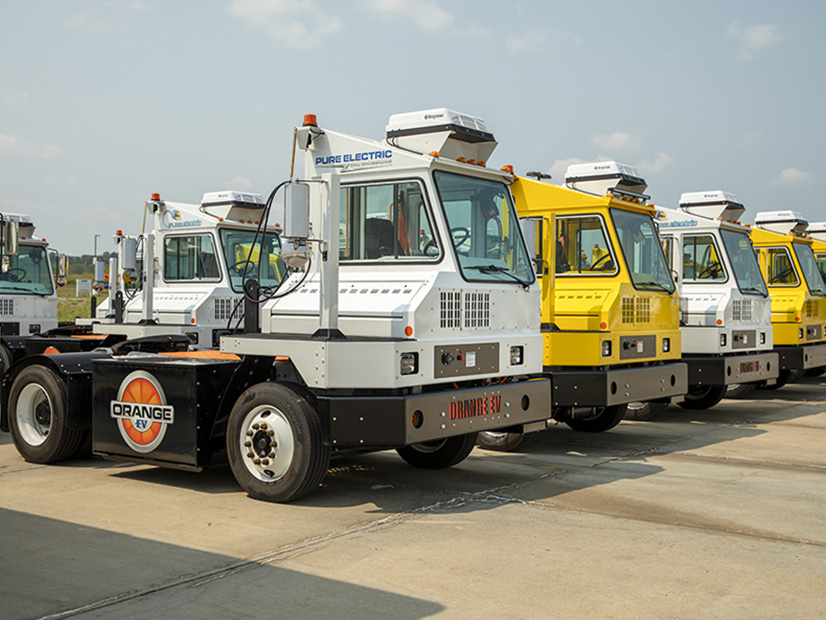
As the California Air Resources Board moves toward requirements to electrify truck fleets, concerns are surfacing about the demands large electric vehicles will put on an already-strained grid.
A wide range of stakeholders commented on the issue during a medium- and heavy-duty infrastructure workgroup meeting that CARB hosted last week as part of its process for developing the Advanced Clean Fleets regulation.
“We obviously have power delivery problems today in California,” said Thomas Jelenic, vice president of the Pacific Merchant Shipping Association (PMSA). “And as we intensify electrification, we become more vulnerable. So what we have been doing in the past is not sufficient.”
Jelenic asked how electric resilience would be provided to ports, which he described as “a node of everything heavy-duty that’s going to be electrified in the future.” He said a PMSA analysis found that California ports would need about 600 MW for future transportation electrification — seemingly more than a microgrid would provide.
The goal of the Advanced Clean Fleets regulation is to accelerate the adoption of zero-emission trucks and buses by requiring fleets that are well-suited for electrification to transition to ZEVs where feasible. An informal discussion draft of the regulation was released in September.
Wastewater Worries
Eva Plajzer, assistant general manager for engineering and operations at the Rancho California Water District in Temecula, called the timing of the regulation unrealistic. The proposed rule would require half of new vehicles purchased for public fleets to be electric starting in 2024, increasing to 100% in 2027.
Plajzer asked whether grid reliability issues would be addressed by the time the fleet regulations take effect.
“This is a tremendous concern,” Plajzer said. “When do you see having enough capacity on the grid where this reliability issue is no longer significant?”
Plajzer said Rancho Water, which provides water and sewer service, doesn’t have the luxury of taking several days off because of a power outage, such as a public safety power shutoff.
She said the district has about 8 MW of solar power. But it doesn’t have space to add the “football field of batteries” it would take to provide backup power supply, she added.
In a written chat comment during the meeting, Kiel Pratt, vehicle-grid integration unit supervisor at the California Energy Commission, suggested that Plajzer look at the Laguna Wastewater Treatment Plant in Santa Rosa. The plant has engines fueled by biogas produced on-site, he said, as well as a photovoltaic system and battery storage.
Jason Dake, vice president of legal and regulatory affairs for Orange EV, a manufacturer of industrial EVs, pointed to the challenges of terminal tractors that may be used around-the-clock at distribution centers. The trucks are often “clumped together” geographically in warehouse districts, such as those in the Inland Empire, he said.
“Terminal tractors don’t have routes,” Dake said. “They are located on that site. They charge continuously during the day. That presents a very localized stress on the grid.”
Another issue raised during the meeting is that truck fleets are typically in use during the day and therefore can’t charge during off-peak times when solar power is plentiful. Charging overnight may rely on gas-fueled power that doesn’t have the same emissions-reduction benefits, a participant said in chat-section comments.
Leslie Goodbody from CARB’s Mobile Source Control Division said the agency is aware of the issue.
Planning Ahead
Utility representatives who participated in the meeting urged stakeholders to let them know in advance of plans to electrify fleets.
“The key thing is lead time — letting us know sooner than later that you’re planning to electrify,” said Vishal Patel, principal manager of integrated system analysis at Southern California Edison.
“Getting that discussion started is really important for the utility to be aware so we can put that into our processes.”
The Jan. 12 workgroup meeting was the third in a series of sessions related to Advanced Clean Fleets. The meeting’s focus was electricity and the grid. CARB is now planning a follow-up meeting on a date to be determined.
Another meeting, focused on costs and funding, was scheduled for this week but has been postponed to a date yet to be decided.
